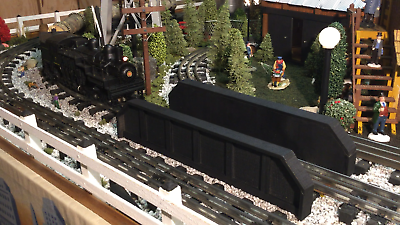Building Techniques
Optimizing Model Railroad Operations: Strategies for Timetables, Car Forwarding, and More

Introduction to Model Railroad Operations
We are on a journey through the intricate and fascinating world of model railroad operations, where precision meets creativity. Model railroading is not just about building tracks and watching trains run; it’s an art that simulates the real-world operations of a railroad. From managing timetables to ensuring efficient car forwarding, each aspect is crucial for a seamless operation.
The Heart of Operations: Timetables
Timetables are the backbone of any railroad service, dictating the schedule of trains across the network. In model railroading, creating a realistic timetable enhances the experience, bringing a sense of order and authenticity. We meticulously plan timetables to ensure that every train has a clear path, reducing conflicts and ensuring a smooth flow of traffic.
Car Forwarding: The Logistics of Movement
Car forwarding is a critical component, involving the movement of freight cars from their origin to their destination. This process requires careful planning and execution. We use waybills, which are documents providing details about the freight, its origin, destination, and routing instructions, to track each car’s journey. This level of detail adds depth to the model railroad operations, creating a dynamic and engaging environment.
Waybills: Tracking the Journey
Waybills are not just paperwork; they are the narrative of each car’s purpose and destination. These documents guide the operations team in managing the flow of freight, ensuring that every car reaches its intended location. We integrate waybills into our operations to maintain an accurate record and to add a layer of complexity that mirrors real-life railroading.
Session Planning: Preparing for Success
A successful operation begins with thorough session planning. We plan every session with precision, considering all variables from train availability to crew resources. This preparation allows us to anticipate challenges and devise solutions, ensuring that each operating session is as efficient and enjoyable as possible.
Train Orders: Directives on the Rails
Train orders are essential for directing locomotives and their crews. These orders provide instructions for train movements, ensuring safety and efficiency on the tracks. We craft these orders with care, balancing the needs of the railroad with the realism that enthusiasts seek.
Dispatching: The Conductor’s Perspective
Dispatching is the act of coordinating train movements across the network. A dispatcher must have a broad view of the operations and the ability to make quick decisions. We simulate this role, giving operators the chance to experience the responsibility and challenge of keeping the railroad running smoothly.
Freight Yard Management: A Hub of Activity
The freight yard is a bustling hub where cars are sorted and prepared for their next journey. Effective freight yard management is key to preventing bottlenecks and ensuring that freight is processed efficiently. We focus on realistic yard operations, from switching cars to managing inbound and outbound traffic.
Passenger Services: Catering to Commuters
Passenger services add a human element to model railroading, representing the service provided to communities along the railroad. We design passenger services with attention to detail, from the scheduling of trains to the design of stations, ensuring that passenger operations are a central part of the experience.
Crew Scheduling: Manpower Behind the Machines
Behind every train is a crew responsible for its operation. Crew scheduling is an important aspect that we incorporate into our model railroad operations. By assigning roles and managing schedules, we create a realistic working environment that reflects the human side of railroading.
Operating Rules: Safety and Standards
Operating rules are the regulations that govern the safe and efficient movement of trains. We adhere to a set of operating rules that guide our model railroad operations, ensuring that every participant understands their role and responsibilities. These rules are not just for show; they are integral to the operation and safety of the railroad.
Conclusion
In the world of model railroading, operations are what bring the railroad to life. By focusing on timetables, car forwarding, waybills, session planning, train orders, dispatching, freight yard management, passenger services, crew scheduling, and operating rules, we create a rich and immersive experience. Whether you are a seasoned operator or a newcomer to the hobby, understanding and optimizing these aspects will enhance your model railroad operations and take your experience to new heights. Join us in this endeavor and see your model railroad come alive with the bustle of a fully operational miniature world.

Hi there! I’m Timothy Robinson, a 51-year-old male living in Denver, CO, US. As a News Editor for NewsRoomFeed.com, I bring you the latest and most accurate news stories daily. With my degree from UNT, I’ve honed my skills in journalism and storytelling to deliver informative and engaging content to our readers.
But I’m not just all work and no play. Outside of my career, I have diverse interests and hobbies that bring joy and balance to my life. One of my passions is building custom model trains. I spend countless hours in my garage, immersing myself in the creative process of assembling and detailing the intricate train engines. I also construct scale tracks that accurately represent real-world railway systems, complete with miniatures of American Home Town railroad depots and authentic-looking woodland scenery.
You’ll often find me exploring the breathtaking mountains and trails around Denver when I’m not in my garage. Hiking is my way of finding solace in the great outdoors, where I can embrace nature’s serenity and tranquility. From conquering challenging summits to enjoying a leisurely stroll, hiking provides me with the perfect blend of physical activity and mental rejuvenation.
But above all, I value spending quality time with my family. We bond over game nights, embark on exciting road trips, and savor delicious home-cooked meals together. These moments of connection and love create cherished memories that will last a lifetime.
Through my passion for model trains, love for hiking, and devotion to family, I lead a well-rounded and fulfilling life outside my role as a dedicated News Editor. Stay tuned for more as I explore the news world and share my adventures.





